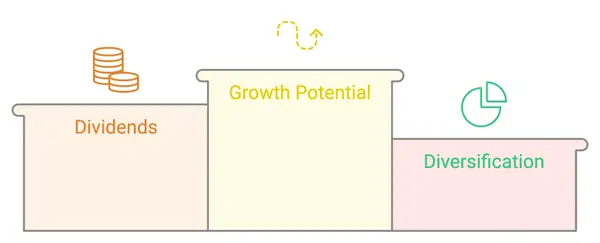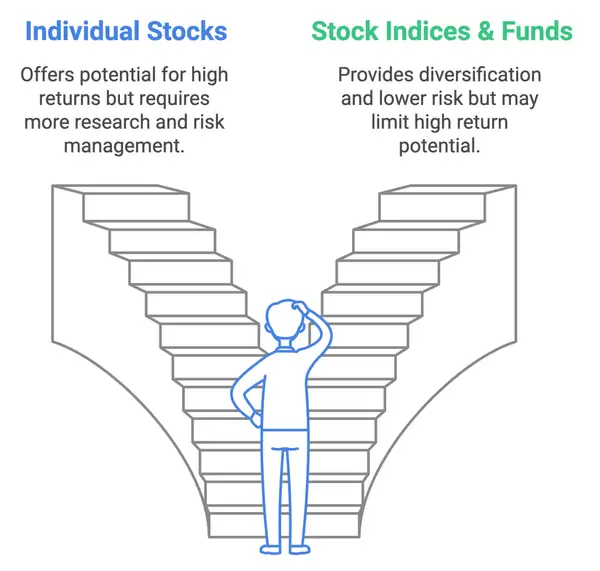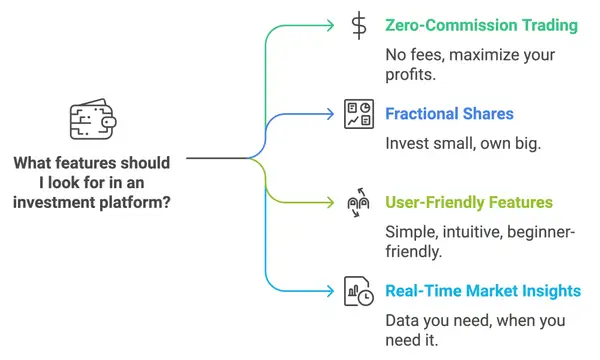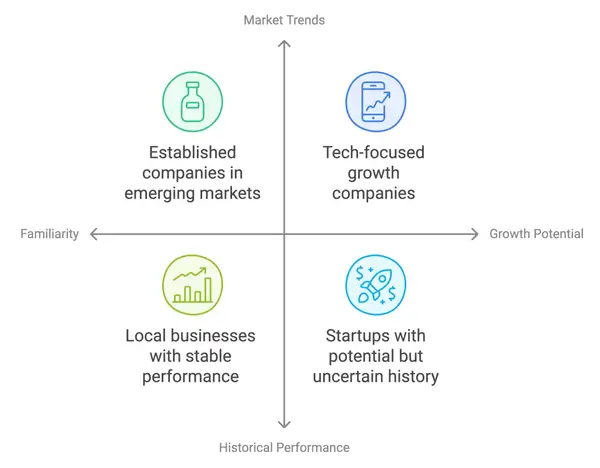How to Invest in the Stock Market: A Beginner’s Guide

Deciding where and how to invest can be overwhelming these days. The stock market remains a solid choice for many, often seen as a more traditional and stable way to grow wealth compared to the volatility of newer assets. Yet, even within the stock market, it can feel like a complicated jungle—full of confusing jargon, advice, and high stakes, where the “lions” often prey on the “sheep.”
But as Peter Lynch once wisely said, “The key to making money in stocks is not to get scared out of them.”
It is understandable that the stock market can feel like a scary place filled with high tension. But here at Morpher, we don’t believe that financial markets should be limited to a specific group while potential investors wait on the sidelines. That’s why we’ve worked to simplify the process with zero-commission trading and fractional investing, making it easy for everyone to get started. Even with this straightforward approach, it’s still important to understand the basics, so we’ve prepared this guide for all our future traders.
We’re here to answer some key questions that might be holding you back:
- Where do I start to invest in the stock market?
- How do I choose the right platform for stock investing?
- Can I invest in international stock markets from anywhere?
- Can I invest in the stock market with a small budget?
- Is now a good time to invest in the stock market?
We know it’s bold to answer all of these questions in one guide, but we will keep it compact, easy to follow, and transparent. After reading this guide, with the right tools, knowledge, and approach, you’ll be able to start investing more confidently, no matter where you’re starting from. Let’s break it down and make investing in the stock market truly accessible for everyone.
Stock Market Basics
What is the Stock Market?
The stock market is a system where buyers and sellers come together to trade shares of publicly listed companies. When you buy a share of a company, you own a small part of that company. This ownership is so small that it typically doesn’t require you to get involved in the company’s management or administrative decisions, but you benefit from its financial success through price increases or dividends.
How Does the Stock Market Work?
Companies raise money by selling shares to the public through an initial public offering (IPO). Investors then buy and sell these shares on stock exchanges like the New York Stock Exchange (NYSE) or Euronext. The price of a share is influenced by factors like company performance, market conditions, and investor sentiment.
Why Do People Invest in the Stock Market?

Imagine you invested $1,000 in Apple at its IPO in December 1980, when the stock was priced at $22.00 per share. Adjusting for the five stock splits that have occurred since then, the split-adjusted price at the time of the IPO was just $0.10 per share.
With $1,000, you could have bought 10,000 shares of Apple at the IPO. Fast forward to today, and Apple’s stock is valued at over $175 per share. If you sold your 10,000 shares today, your $1,000 investment would be worth over $2.1 million.
Everyone would admit that it's an extraordinary return, demonstrating the power of long-term investing and compound growth. The annualized return on this investment is an impressive 19.22%, which shows how powerful it can be to invest in companies that continue to innovate and grow over decades.
Major Stock Exchanges Around the World

Stock Market Terms Cheat Sheet
- Stocks: Ownership shares in a company e.g Tesla Inc. ($TSLA) Stock.
- Stock Indices: A collection of stocks used to represent a segment of the market e.g. S&P 500, Dow Jones.
- Dividends: Payments made to shareholders from a company’s profits.
- Portfolio: A collection of all the investments you own (stocks, crypto, ETFs, etc.).
- Short Selling (Shorting): Selling a stock you don’t own, hoping to buy it back later at a lower price.
- Going Long: Buying a stock with the expectation that its price will rise.
- Stock Brokerage: A platform or firm that acts as an intermediary to facilitate the buying and selling of stocks for investors. They execute trades on behalf of the investor.
- Stock Exchanges: Physical or electronic marketplaces where stocks are bought and sold directly. Examples include the NYSE, Nasdaq, and LSE mentioned above.
- Stock Exchange Platforms: Online platforms that allow you to access stock exchanges and execute trades directly from your account. These platforms are the easiest, quickest, and most cost-efficient way to invest in the stock market. You’re in luck, as you’re currently on one of these platforms by reading our blog!
The Two Paths of Stock Market Investing
When investing in the stock market, you commonly have two main paths to choose from:

Individual Stocks
On Morpher, you can invest in more than 700 U.S. stocks, including popular companies like Apple, NVIDIA, and Coinbase. Individual stocks are ideal for investors who enjoy actively managing their portfolios and researching specific companies to uncover potential opportunities.
- Advantages: You have full control over which companies to invest in, allowing you to focus on businesses or industries you understand and believe in. If the company performs well, your returns can be significant.
- Challenges: Individual stocks can be volatile, and success requires research, time, and a willingness to monitor market trends. Diversification is also harder to achieve unless you have significant capital to invest across multiple companies.
Grouped Investments (ETFs, Mutual Funds, and Stock Indices)
For investors seeking a simpler, diversified approach, options like ETFs and mutual funds are often the go-to. These pool money from multiple investors to invest in a basket of stocks, often mimicking a broader market index. However, these options typically come with management fees and restrictions, which can quickly eat into profits, especially if you’re investing with a small budget.
Instead, stock indices stand out as a more streamlined and accessible choice. With indices, you can invest in a group of stocks together without needing to cherry-pick individual companies.
Here are some of the most popular stock indices available on Morpher:
- S&P 500: Top U.S. companies across industries.
- Nasdaq-100: A tech-heavy index featuring leading companies like Microsoft and Amazon.
- Dow Jones Industrial Average: A mix of large, well-established corporations.
- Global Indices: Such as the AEX (Netherlands), DAX (Germany), and CAC 40 (France).
Investing in indices gives you exposure to entire markets or sectors with a single investment, providing instant diversification without the need to manage multiple individual stocks. If you’ve decided to explore this path further, be sure to check out our comprehensive Indices Trading Guide for complete insights after finishing this article.
Where to Start?
Now that you've decided to invest in the stock market, it's time to take the first real steps. Assuming you've already educated yourself and set your investment goals, here’s how you can start investing in the stock market with 3 easy steps:
1. Choose a Stock Investment Platform
The first step in your stock market journey is selecting the right brokerage or online platform. Today, online platforms are the preferred choice for many investors because they provide more freedom, a low-risk environment to practice, and easy access to global markets.

With Morpher, you get zero commissions, fractional shares, and an AI-powered system that keeps you updated with the latest stock market news—all in one platform. Choosing the right place to start can make all the difference in your investment journey. Ready to see for yourself? Discover the future of trading today.
2. Do Your Research
Once you’ve chosen a platform, the next step is deciding what to invest in. This involves researching specific assets based on your goals and risk tolerance.


3. Make Your First Investment
After deciding what to invest in, it’s time to make your first trade. To guide you through the process, let’s walk through a case study featuring Jan-Pieter, our beginner trader from Belgium.
Investing in the Stock Market with a Small Budget

Meet Jan-Pieter, a 26-year-old recent graduate from Belgium. He currently works as a digital marketer at a tech startup. While his salary is still modest, he’s managed to save €1,000 and has decided to invest it in the stock market to start building his financial future. Let’s walk through how Jan-Pieter begins his journey.
Step 1: Creating His Morpher Account
Jan-Pieter starts by creating an account on Morpher. He deposits his €1,000 and explores the platform’s features. With zero commissions and fractional shares, he knows he can make the most of his budget. Full coverage about Morpher's zero commission trading here.
Step 2: Exploring Stocks and Indices
Jan-Pieter begins by browsing the available individual stocks and stock indices on Morpher. Being someone who closely follows industry news, he decides that tech companies align with his interests and knowledge. Using Morpher’s real-time market insights, he quickly checks for any significant updates or trends in the tech sector.
Step 3: Conducting Technical Analysis
To better understand the market trends, Jan-Pieter uses Morpher’s charting tools, powered by TradingView. He reviews simple but powerful indicators like RSI and MACD to gauge momentum and potential entry points. For more on how to perform a technical analysis, check out our comprehensive guide here.
Step 4: Diversifying His Portfolio
After careful consideration, Jan-Pieter decides to divide his €1,000 across three assets to diversify his portfolio:
MicroStrategy Stock– €300: He invests in this company because of its innovative role in technology and analytics.
Morpher AI Index- €400: This index taps into the next technological revolution, focusing on companies embracing artificial intelligence. It’s a balanced mix of up-and-coming players like Palantir and Duolingo, alongside established leaders like Microsoft and NVIDIA. With medium risk and a focus on future revenue growth, this index aligns with Jan-Pieter’s long-term vision.
Nasdaq-100- €300: To further diversify, he invests in this tech-heavy index, gaining exposure to a wide range of leading companies across the U.S. tech sector.
Step 5: Setting Stop Losses
To manage his risk, Jan-Pieter sets stop-loss orders for his investments. This ensures that if the value of any asset drops below a certain threshold, it will be automatically sold, protecting his portfolio from significant losses. By using stop-losses, he gains peace of mind while navigating the market’s ups and downs.
What Happens Next?
Jan-Pieter’s journey is just beginning. He plans to keep an eye on his investments, using Morpher’s insights and tools to stay informed. With a diversified portfolio and an easy, yet effective risk management strategy, he’s taken a confident first step toward long-term financial growth.
Is Now a Good Time to Invest in the Stock Market?
When is there a better time than now? The stock market is primed for opportunities, especially following the recent U.S. elections. Historically, markets often experience some volatility around election periods but tend to stabilize and rally as political uncertainties settle. With optimism growing about future economic policies, key indices like the S&P 500 and Nasdaq-100 are showing promising trends.
Investing now allows you to position yourself for potential long-term growth, taking advantage of market conditions as they unfold. Whether you’re looking to build a diversified portfolio or target specific sectors like technology, there’s no time like the present to start.
If you’re ready now, Morpher makes it easier than ever to get started. Download the app for the best zero-commission stock trading experience and begin your investment journey today. With no penalties for beginner mistakes, it’s the perfect place to learn and grow. Plus, start investing with your welcome bonus and see how simple stock market investing can be!
FAQ: Your Stock Market Investment Journey
1. Can I invest with a small budget?
Yes! We actually encourage to start small for your learning curve. With fractional investing, even a small budget like €50 or €100 can be used to purchase shares in high-value stocks or indices. Morpher allows you to start with any amount, making investing accessible to everyone.
2. What are stock indices, and should I invest in them?
Stock indices represent the performance of a group of companies, such as the S&P 500 or Nasdaq-100. They offer instant diversification and are a great option for beginners who want broad market exposure without picking individual stocks.
3. How do I research which stocks or indices to invest in?
Start with industries or companies you understand. Use tools like performance charts, earnings reports, and technical indicators (e.g., RSI and MACD) to analyze trends. Morpher’s platform offers these insights along with real-time data to guide your decisions.
4. How can I manage my risks when investing?
Setting stop-loss orders is a simple way to protect your portfolio. This ensures that if an asset’s value falls below a certain point, it will be automatically sold to minimize losses.
5. Can I invest in international markets from Europe, for example from Belgium?
Absolutely. Platforms like Morpher give you access to U.S. stocks, global indices (e.g., DAX, CAC 40), and more—all from one account.
6. How do I get started with investing to stock market on Morpher?
Simply register here, deposit your funds, and explore the range of stocks and indices available. You’ll even receive a welcome bonus from us to help you kickstart your journey.

Disclaimer: All investments involve risk, and the past performance of a security, industry, sector, market, financial product, trading strategy, or individual’s trading does not guarantee future results or returns. Investors are fully responsible for any investment decisions they make. Such decisions should be based solely on an evaluation of their financial circumstances, investment objectives, risk tolerance, and liquidity needs. This post does not constitute investment advice.

Painless trading for everyone
Hundreds of markets all in one place - Apple, Bitcoin, Gold, Watches, NFTs, Sneakers and so much more.

Painless trading for everyone
Hundreds of markets all in one place - Apple, Bitcoin, Gold, Watches, NFTs, Sneakers and so much more.









